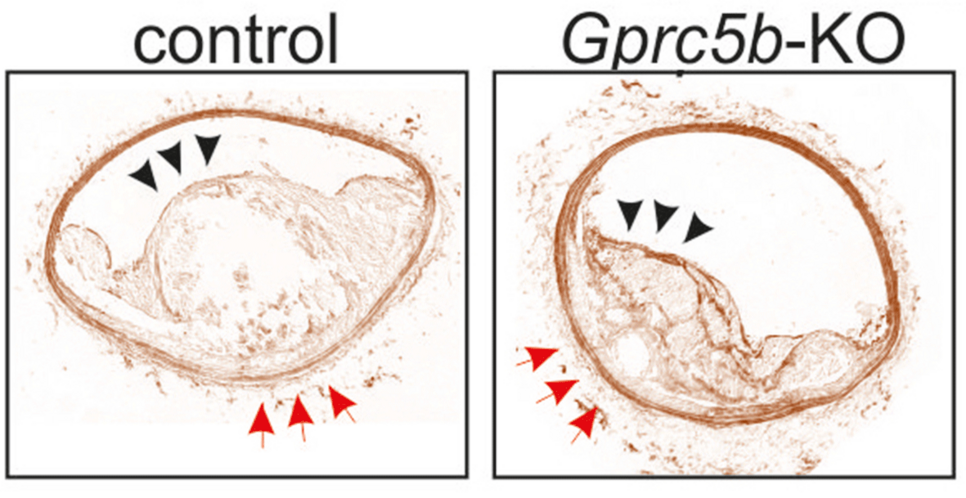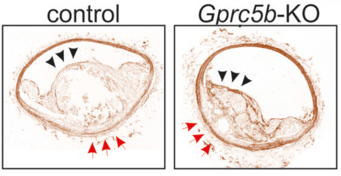Function decoded: receptor GPRC5B influences blood pressure and the development of atherosclerosis
Smooth muscle cells in blood vessel walls play a crucial role
G protein-coupled receptors play a central role in the communication between cells and are important targets for drug therapies. Despite intensive research, there are still individual receptors in this family whose function is not known. Scientists from the Max Planck Institute for Heart and Lung Research in Bad Nauheim have now been able to decode the functioning of another family member, the GPRC5B receptor. The receptor influences activity and behavior of smooth vascular muscle cells and is thus involved in the regulation of blood pressure and the development of atherosclerosis. The researchers are now planning to search for inhibitors that can be used to influence the function of the receptor.
Blood vessels are often compared to water pipes. A crucial difference, however, is that vessel walls are very active. Cells in the vascular wall exchange information with blood and neighboring cells. This takes place via a large number of signaling molecules and receptors in the cell as receivers of these signals. In this way, for example, the activity of the smooth muscle cells in the vascular walls and subsequently, among other things, the blood pressure is influenced. In addition, smooth muscle cells change their appearance and function in the course of the development of atherosclerosis: their ability to contract is reduced by a breakdown of the muscle proteins in the cells. This process is described as dedifferentiation and is also mediated through the communication of signaling molecules with the cell receptors.
With around 800 members, G-protein-coupled receptors represent the largest group of receptors in cell membranes. However, with more than a hundred individual receptor molecules, their role is so far completely unknown. Scientists from Nina Wettschureck's group in the Pharmacology Department at the Max Planck Institute for Heart and Lung Research in Bad Nauheim have now been able to show that a G-protein-coupled receptor called GPRC5B plays an important role in the activity of smooth vascular muscle cells. “We became aware of the receptor through data from a gene expression analysis. These showed that GPRC5B is more common in smooth vascular muscle cells of arteries regulating blood pressure,” says Wettschureck. In addition, GPRC5B is also increased in dedifferentiated smooth muscle cells.
The Max Planck researchers then investigated the consequences of this inactivation of the receptor in mice in which GPRC5B can be switched off by genetic engineering. "In the first step, we found that these mice are protected from high arterial pressure," said Jorge Carvalho, first author of the study. "In the second step, we found that these animals' vessels react more strongly to prostacyclin, a substance that relaxes the smooth muscle cells and thus widens the blood vessels."
Through further experiments on mice and cultured cells, the Bad Nauheim scientists went deeper into the mechanism of this reaction: “We found that GPRC5B impedes the transport of the prostacyclin receptor to the cell surface. In consequence, animals without GPRC5B have more prostacyclin receptors on the surface of their smooth muscle cells. This at least partially protects them from the development of high blood pressure,” says Carvalho. In an experiment, this protection could be removed by blocking the prostacyclin receptor.
The researchers also discovered that GPRC5B additionally plays a role in the development of atherosclerosis: “It was already known that prostacyclin plays a role in the dedifferentiation of smooth muscle cells as one of the first steps in the development of atherosclerosis. In mice in which GPRC5B was switched off, we actually found a lower tendency to atherosclerosis. The smooth muscle cells remained in a differentiated state,” said Carvalho.
With the newly discovered function of GPRC5B, a new starting point is now available for the treatment of hypertension and atherosclerosis. “Unfortunately, there is currently no known inhibitor for GPRC5B. We also do not yet know of any substance that would prevent the binding between GPRC5B and the prostacyclin receptor. This binding would be a second starting point for a therapy,” said Wettschureck. That is why the Bad Nauheim researchers are now initially planning to specifically search for substances that interfere with the activity of the GPRC5B.
MH/NW

Less atherosclerosis if GPRC5B is absent. The figure shows a microscopic section through blood vessels. While a large plaque has grown inside the blood vessel in the control (left), this is much smaller in mice without active GPRC5B (right).
